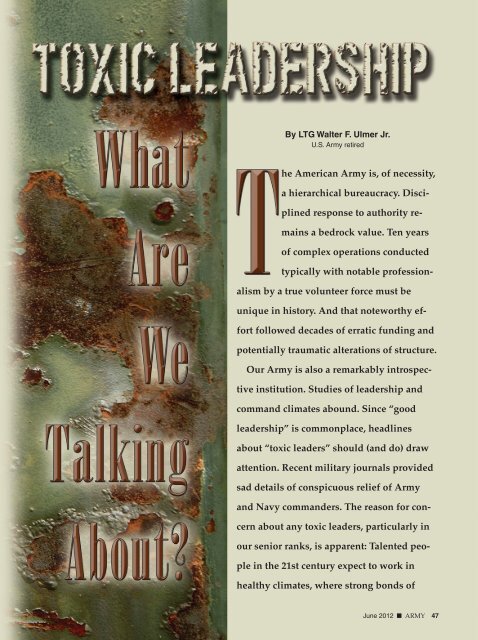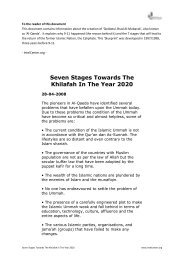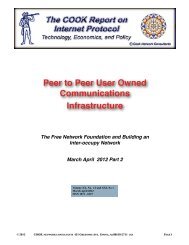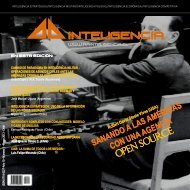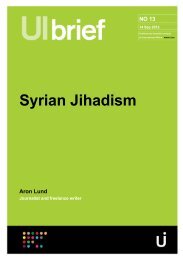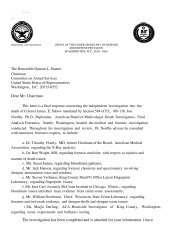Toxic Leadership: What Are We Talking About? - Association of the ...
Toxic Leadership: What Are We Talking About? - Association of the ...
Toxic Leadership: What Are We Talking About? - Association of the ...
Create successful ePaper yourself
Turn your PDF publications into a flip-book with our unique Google optimized e-Paper software.
By LTG Walter F. Ulmer Jr.<br />
U.S. Army retired<br />
he American Army is, <strong>of</strong> necessity,<br />
a hierarchical bureaucracy. Disciplined<br />
response to authority remains<br />
a bedrock value. Ten years<br />
<strong>of</strong> complex operations conducted<br />
typically with notable pr<strong>of</strong>essionalism<br />
by a true volunteer force must be<br />
unique in history. And that noteworthy ef -<br />
fort followed decades <strong>of</strong> erratic funding and<br />
potentially traumatic alterations <strong>of</strong> structure.<br />
Our Army is also a remarkably introspective<br />
institution. Studies <strong>of</strong> leadership and<br />
command climates abound. Since “good<br />
leadership” is commonplace, headlines<br />
about “toxic leaders” should (and do) draw<br />
attention. Recent military journals provided<br />
sad details <strong>of</strong> conspicuous relief <strong>of</strong> Army<br />
and Navy commanders. The reason for concern<br />
about any toxic leaders, particularly in<br />
our senior ranks, is apparent: Talented people<br />
in <strong>the</strong> 21st century expect to work in<br />
healthy climates, where strong bonds <strong>of</strong><br />
June 2012 ■ ARMY 47
mutual trust facilitate mission accomplishment and support<br />
long-term institutional strength. <strong>Toxic</strong> leaders corrupt<br />
healthy climates. Indeed, <strong>the</strong>ir very presence, even in small<br />
numbers, undermines confidence in <strong>the</strong> institution’s commitment<br />
to high standards <strong>of</strong> leadership.<br />
Defining ‘<strong>Toxic</strong> Leader’<br />
Defining toxic leader is <strong>the</strong> first priority before addressing<br />
numbers, impact, cause and solution. <strong>We</strong>bster’s defines<br />
toxic as poisonous, not far from destructive or harmful. Naturally,<br />
<strong>the</strong> definition varies with <strong>the</strong> culture: Some routine<br />
styles <strong>of</strong> command aboard <strong>the</strong> HMS Bounty would not be<br />
tolerated today. Soldiers today have suitably high expectations<br />
about <strong>the</strong> kind <strong>of</strong> leader behavior we have identified<br />
as doctrine.<br />
In response to a Secretary <strong>of</strong> <strong>the</strong> Army tasking in 2003,<br />
U.S. Army War College faculty and students stated that<br />
toxic leaders “are focused on visible short-term mission accomplishment<br />
… provide superiors with impressive, articulate<br />
presentations and enthusiastic responses to missions<br />
… [but] are unconcerned about, or oblivious to, staff or<br />
troop morale and/or climate … [and] are seen by <strong>the</strong> majority<br />
<strong>of</strong> subordinates as arrogant, self-serving, inflexible,<br />
and petty.” This definition reminds us that not all elements<br />
<strong>of</strong> a toxic personality are independently destructive. <strong>We</strong><br />
prize “articulate presentations and enthusiastic responses<br />
to missions.” The phrase in <strong>the</strong> 2003 definition, “are seen<br />
by <strong>the</strong> majority <strong>of</strong> subordinates,” is significant. In determining<br />
leader toxicity, group consensus is powerful.<br />
The U.S. Army War College study, “<strong>Leadership</strong> Lessons<br />
at Division Command Level-2010: A Review <strong>of</strong> Division<br />
Commander Leader Behaviors and Organizational Climates<br />
in Selected Army Divisions after Nine Years <strong>of</strong> War,”<br />
surveyed and interviewed 183 <strong>of</strong>ficers from four divisions<br />
just returning from deployment in Operation Iraqi Freedom<br />
or Operation Enduring Freedom. The study summarized<br />
<strong>of</strong>ficer views <strong>of</strong> toxic leaders as “self-serving, arrogant,<br />
volatile, and opinionated to <strong>the</strong> point <strong>of</strong> being<br />
organizationally dysfunctional … very persuasive, responsive,<br />
and accommodating to <strong>the</strong>ir seniors.” In those interviews,<br />
<strong>the</strong> report continued, “it seemed clear that <strong>of</strong>ficers<br />
were not describing <strong>the</strong> ‘tough but fair,’ or even <strong>the</strong> ‘oversupervisor,’<br />
or <strong>the</strong> ‘not really good with people,’ or even<br />
<strong>the</strong> ‘rarely takes tactical initiative.’” These <strong>of</strong>ficers’ perceptions<br />
make a discernible, important distinction between<br />
tough and toxic. An assessment <strong>of</strong> a leader as inferior or<br />
LTG Walter F. Ulmer Jr., USA Ret., commanded <strong>the</strong> 3rd Armored<br />
Division and III Corps, was director <strong>of</strong> human resources<br />
development at HQDA, and served as Commandant<br />
<strong>of</strong> Cadets at USMA. He served as president and CEO <strong>of</strong> <strong>the</strong><br />
Center for Creative <strong>Leadership</strong> and is co-author <strong>of</strong> several<br />
studies <strong>of</strong> <strong>of</strong>ficer leadership including <strong>the</strong> U.S. Army War College<br />
1970 “Study on Military Pr<strong>of</strong>essionalism;” <strong>the</strong> 2000<br />
CSIS study, “American Military Culture in <strong>the</strong> Twenty-first<br />
Century;”and <strong>the</strong> 2004 and 2010 studies, “<strong>Leadership</strong> Lessons<br />
at Division Command Level.”<br />
even unsatisfactory based on decision-making inadequacies,<br />
clumsy interpersonal skills or lack <strong>of</strong> drive did not automatically<br />
label him as toxic. It is also possible to “make<br />
tough, sound decisions on time,” “see <strong>the</strong> big picture [and]<br />
provide context and perspective,” and “get out <strong>of</strong> <strong>the</strong><br />
headquarters and visit <strong>the</strong> troops”—<strong>the</strong> top behaviors <strong>of</strong> a<br />
highly regarded senior leader as reported in a 2004 division<br />
commander study—and still be conspicuously toxic<br />
as judged by a majority <strong>of</strong> subordinates. In o<strong>the</strong>r words,<br />
while all toxic <strong>of</strong>ficers are ultimately poor leaders, not all<br />
poor leaders are toxic. The forthcoming version <strong>of</strong> Army<br />
Doctrine Publication 6-22, Army <strong>Leadership</strong> notes, “<strong>Toxic</strong><br />
leadership is a combination <strong>of</strong> self-centered attitudes, motivations<br />
and behaviors that have adverse effects on subordinates,<br />
<strong>the</strong> organization and mission performance.” A recent<br />
study on ethical behavior by <strong>the</strong> Army Center <strong>of</strong><br />
Excellence for <strong>the</strong> Pr<strong>of</strong>essional Military Ethic, “ACPME<br />
Technical Report 2010-01: MNF-I Excellence in Character<br />
and Ethical <strong>Leadership</strong> (EXCEL) Study,” stated, “The<br />
Army should develop leaders who understand <strong>the</strong> line between<br />
being firm … and being abusive; and identify and<br />
separate those found to be abusive.” Identify and separate<br />
are <strong>the</strong> important words.<br />
A proposed definition: <strong>Toxic</strong> leaders are individuals<br />
whose behavior appears driven by self-centered careerism<br />
at <strong>the</strong> expense <strong>of</strong> <strong>the</strong>ir subordinates and unit, and whose<br />
style is characterized by abusive and dictatorial behavior<br />
that promotes an unhealthy organizational climate. O<strong>the</strong>r<br />
observations about toxic leaders from surveys, interviews<br />
and literature—most derived from research and discussions<br />
about senior leaders or managers—are:<br />
■ They rarely take blame or share glory.<br />
■ They are not toxic all <strong>the</strong> time, or to all people.<br />
■ They are rarely if ever toxic when in <strong>the</strong> company <strong>of</strong><br />
“<strong>the</strong> boss.”<br />
■ They sometimes have good ideas and accomplish<br />
good things.<br />
■ They can be charming when <strong>the</strong> occasion fits.<br />
■ They are frequently described as extremely bright and<br />
hard-working.<br />
■ They <strong>of</strong>ten have a coterie <strong>of</strong> devoted “fans” who keep<br />
appearing on <strong>the</strong>ir staffs.<br />
■ Most have been seen as toxic by subordinates since<br />
early in <strong>the</strong>ir career.<br />
■ Their boss ei<strong>the</strong>r does not know or pretends not to know,<br />
and almost never records, <strong>the</strong>ir abuse <strong>of</strong> subordinates.<br />
Numbers <strong>of</strong> <strong>Toxic</strong> Leaders<br />
Because <strong>the</strong>re is no standard definition <strong>of</strong> toxic, because<br />
perceptions about a superior’s behavior are subjective, because<br />
our Army culture puts loyalty to <strong>the</strong> leader and ability<br />
to absorb hardship <strong>of</strong> all kinds high on <strong>the</strong> attribute list,<br />
and because a degree <strong>of</strong> harshness has characterized some<br />
highly regarded <strong>of</strong>ficers, estimates <strong>of</strong> <strong>the</strong> numbers <strong>of</strong> toxic<br />
leaders are just that—estimates. The data become less subjective,<br />
however, when we can assess also <strong>the</strong> impact <strong>of</strong><br />
toxic leadership on <strong>the</strong> climate <strong>of</strong> <strong>the</strong> organization.<br />
48 ARMY ■ June 2012
The best current reference on <strong>the</strong> toxic leader issue is <strong>the</strong><br />
Center for Army <strong>Leadership</strong> (CAL) “Technical Report 2011-<br />
3,” which garnered some national press recently. Estimates<br />
<strong>of</strong> toxic leaders in that study, which assessed both noncommissioned<br />
and commissioned <strong>of</strong>ficers, ranged into <strong>the</strong> 20<br />
percent level. That very high number might have resulted<br />
in part from a broad interpretation by respondents <strong>of</strong> a<br />
toxic leader, although study members took efforts to ensure<br />
that toxicity was differentiated from simply poor leadership.<br />
A recent survey at <strong>the</strong> U.S. Army Command and General<br />
Staff College, however, found a figure <strong>of</strong> nearly 18 percent.<br />
<strong>What</strong>ever <strong>the</strong> numbers are today, <strong>the</strong> sense <strong>of</strong> <strong>the</strong><br />
<strong>of</strong>ficer corps is that <strong>the</strong>re are undoubtedly toxic leaders<br />
among us with <strong>the</strong> possibility that <strong>the</strong>ir numbers are decreasing<br />
somewhat from some undetermined past date.<br />
One slice <strong>of</strong> information on percentages <strong>of</strong> perceived<br />
toxic leaders among colonels and general <strong>of</strong>ficers—<strong>the</strong><br />
level constituting <strong>the</strong> greatest potential danger to operational<br />
effectiveness and retention <strong>of</strong> high-quality people—<br />
comes from informal surveys <strong>of</strong> some students at <strong>the</strong> Command<br />
and General Staff College (CGSC) and <strong>the</strong> Army<br />
War College over a period <strong>of</strong> 15 years. (See <strong>the</strong> chart on <strong>the</strong><br />
next page.) These data describing colonels and generals are<br />
derived from inputs from successful student <strong>of</strong>ficers who<br />
had been treated well by <strong>the</strong> institution.<br />
The percentages <strong>of</strong> senior leaders perceived by <strong>the</strong>ir subordinates<br />
to be outstanding/transformational (30–50 percent)<br />
would be viewed as remarkably high in any organization.<br />
Those figures are a tribute to persistent Army<br />
efforts to develop and select good leaders. The “toxic”<br />
numbers, however, are also remarkable. They deserve an<br />
institutional response. A mission command culture could<br />
be strangled by this percentage <strong>of</strong> toxic senior leaders in<br />
<strong>the</strong> force. A very good soldier and scientist, LTC Larry Ingraham,<br />
now deceased, commented on <strong>the</strong> dramatic differences<br />
among subordinate reputations <strong>of</strong> senior <strong>of</strong>ficers,<br />
saying that <strong>the</strong> personnel system that cannot distinguish<br />
between <strong>the</strong> revered and <strong>the</strong> despised must have a fundamental<br />
flaw.<br />
Why <strong>Toxic</strong> Leaders Survive in Our Culture<br />
Military environments are fertile ground for both growing<br />
outstanding leaders and tolerating tyrants. As a culture<br />
we value cooperation, loyalty and respect for authority. <strong>We</strong><br />
honor a “can-do” attitude. <strong>We</strong> build unit pride and are uncomfortable<br />
with malcontents. <strong>We</strong> rightly prize mission accomplishment.<br />
As long as <strong>the</strong> mission is relatively shortterm,<br />
before a destructive climate raises its ugly head, <strong>the</strong><br />
toxic can-do personality can prosper. Subordinates are reluctant<br />
to identify <strong>the</strong>ir boss as toxic. They feel a loyalty<br />
and do not want to embarrass <strong>the</strong>ir unit. They want to<br />
“survive” <strong>the</strong>mselves and not be written <strong>of</strong>f as troublemakers.<br />
In addition, it takes a very strong and perceptive<br />
boss to identify a subordinate as toxic and take action.<br />
Most actions to relieve a toxic leader were set in motion<br />
only after a public spectacle forced an investigation that<br />
uncovered toxic leadership as a root cause.<br />
Considerable work has been done in <strong>the</strong> social, behavioral<br />
and cognitive sciences on toxic or destructive leaders.<br />
An article in <strong>the</strong> June 2007 issue <strong>of</strong> The <strong>Leadership</strong> Quarterly,<br />
“The <strong>Toxic</strong> Triangle: Destructive Leaders, Susceptible Followers,<br />
and Conducive Environments,” provides an excellent<br />
summary, stating, “Three components <strong>of</strong> charisma apply<br />
to destructive leaders: vision, self-presentational skills,<br />
and personal energy.” It is interesting to see how closely<br />
<strong>the</strong>se descriptions apply to current Army <strong>of</strong>ficers. The referenced<br />
paper explains <strong>the</strong> role <strong>of</strong> <strong>the</strong> narcissistic personality<br />
whose “sense <strong>of</strong> entitlement <strong>of</strong>ten leads to self-serving<br />
abuses <strong>of</strong> power.” The fact that toxic behavior is typically<br />
linked to a substantially compromised personality does<br />
not augur well for on-<strong>the</strong>-job remediation or development<br />
as an institutional solution.<br />
Although alerted for years to <strong>the</strong> issue, as an institution<br />
we have been reluctant to confront it directly. <strong>We</strong> have put<br />
faith in incremental adjustments to education, training and<br />
development systems. There has been little urgency to act<br />
systematically. The rarely conspicuous cases were handled<br />
individually with apparently rare exploration <strong>of</strong> underlying<br />
cultural issues. This was partly because our institution<br />
has performed well overall, because <strong>of</strong> our <strong>of</strong>ten “if it ain’t<br />
broke don’t fix it” mentality, and because <strong>the</strong> senior leader<br />
time and energy needed to fix complex internal systems<br />
were understandably captured by immediate crises that<br />
demanded <strong>the</strong>ir attention. Our institution is by no means<br />
broken, but it deserves some refurbishing.<br />
There are lingering doubts within <strong>the</strong> Army about implementing<br />
remedial programs that would give subordinates<br />
any formal voice in <strong>the</strong> personnel management<br />
process. The predominant fear is <strong>of</strong> an eventual weakening<br />
<strong>of</strong> <strong>the</strong> chain <strong>of</strong> command. There are understandable suspicions<br />
also that many reports <strong>of</strong> toxic leadership are from<br />
dissatisfied subordinates who failed to meet <strong>the</strong> legitimate<br />
expectations <strong>of</strong> demanding bosses. That contention is not<br />
supported by recent studies but could provide a rationale<br />
for avoiding <strong>the</strong> unpleasant business <strong>of</strong> digging into complex<br />
personnel systems. The toxic leader phenomenon is a<br />
slowly growing organizational cancer that can be tolerated<br />
by resilient people for a long time before causing sharp institutional<br />
pain.<br />
Solution Concepts<br />
<strong>We</strong> are correctly cautious in adopting practices that have<br />
even a remote possibility <strong>of</strong> compromising command authority.<br />
Even admitting <strong>the</strong>re are toxic leaders in our midst<br />
is problematic for a few <strong>of</strong>ficers. For <strong>the</strong> vast majority <strong>of</strong> <strong>of</strong>ficers<br />
a pretension that <strong>the</strong>re are none seems patently dishonest.<br />
In any case, staying on <strong>the</strong> current path has no rational<br />
hope for solving <strong>the</strong> problem. Meanwhile, tolerance<br />
for toxic leaders among current members <strong>of</strong> <strong>the</strong> force is<br />
conspicuously low. Perceived institutional nonchalance<br />
about <strong>the</strong> situation is a serious contradiction <strong>of</strong> espoused<br />
Army values. The desired mission command culture depends<br />
heavily on an environment <strong>of</strong> mutual trust that only<br />
high-quality leaders can produce.<br />
50 ARMY ■ June 2012
Two <strong>of</strong> <strong>the</strong> categories used in data collected from selected CGSC and War College<br />
student samples during 1996–2010<br />
Estimates in population<br />
Essentially transformational: Inspirational, encouraging, puts mission and troops<br />
first; coaches, builds teams and a healthy climate; sets high standards for self and<br />
o<strong>the</strong>rs; generates and reciprocates trust.<br />
30–50 percent<br />
Essentially toxic: Alienates and abuses subordinates; creates a hostile climate; <strong>of</strong>ten<br />
rules by fear; rejects bad news; seen as self-serving and arrogant; is skillful in upward<br />
relationships; usually bright, energetic and technically competent.<br />
8–10 percent<br />
Various ongoing initiatives must be integrated into a<br />
comprehensive program in which education <strong>of</strong> <strong>the</strong> <strong>of</strong>ficer<br />
corps on objectives, concepts and details <strong>of</strong> <strong>the</strong>se initiatives<br />
would play a major role. As <strong>the</strong> CAL 2011 report states,<br />
“This problem must be attacked simultaneously at several<br />
levels.” A near-term goal is precluding toxic leaders from<br />
getting into <strong>the</strong> pool <strong>of</strong> colonels who are general <strong>of</strong>ficer<br />
candidates—a practice that if carefully explained and fairly<br />
implemented could by itself rejuvenate faith in Army promotion<br />
and selection systems and reinforce important<br />
Army values by practicing what we preach. Such initiatives<br />
include <strong>the</strong> following.<br />
Institute a system for regularly reporting <strong>the</strong> results <strong>of</strong> command<br />
climate surveys. This effort should parallel systems for<br />
reporting o<strong>the</strong>r elements <strong>of</strong> <strong>the</strong> readiness system, with<br />
Army-wide collection <strong>of</strong> periodic data. Battalion-size units<br />
and staffs at division level and higher should be <strong>the</strong> primary<br />
targets for standardized climate assessments.<br />
Climate assessments have been around longer than <strong>the</strong><br />
360 process and remain an important tool for commanders.<br />
They have never been collected Army-wide with <strong>the</strong> same<br />
comprehensive regularity as materiel and training readiness<br />
reports, although we emphasize that troop morale is a<br />
vital ingredient in combat power.<br />
Climate surveys can be designed for user convenience,<br />
are a method <strong>of</strong> reinforcing Army values and can provide<br />
advance warning <strong>of</strong> toxic leadership. (Determination <strong>of</strong><br />
who has access to climate data and <strong>the</strong> levels <strong>of</strong> consolidation<br />
and review <strong>of</strong> reports are issues requiring careful attention.)<br />
Provide selection boards with supplemental information from<br />
subordinates. This will enhance <strong>the</strong> validity <strong>of</strong> <strong>the</strong> top-down<br />
information now available and is <strong>the</strong> heart <strong>of</strong> any serious<br />
attempt to rid <strong>the</strong> institution <strong>of</strong> <strong>the</strong> toxic leader. Exclusively<br />
top-down assessments have failed to eliminate toxic<br />
leaders from hierarchical organizations, even those with<br />
generally solid reputations such as <strong>the</strong> U.S. Army.<br />
The 2010 Division Commander Study recommends: “Revise<br />
significantly <strong>the</strong> process for selection to O-6 command<br />
to ensure that <strong>the</strong>re are no future candidates for Division<br />
Command who have been identified clearly as toxic leaders.<br />
Specifically, provide boards selecting brigade-level<br />
commanders with supplemental data summarizing leadership<br />
behavior assessments taken from a sample <strong>of</strong> <strong>of</strong>ficers<br />
who had served as company commanders or principal<br />
staff <strong>of</strong>fices when <strong>the</strong> individuals being considered were<br />
<strong>the</strong>ir battalion commanders.” The description <strong>of</strong> a proposed<br />
pilot study <strong>of</strong> this procedure explains that <strong>the</strong> assessments<br />
<strong>of</strong> subordinates are taken usually one to three<br />
years after <strong>the</strong> candidate for O-6 command has departed<br />
<strong>the</strong> previous battalion-level command. (This is not use <strong>of</strong> a<br />
360 “feedback” process. That process, designed for enhanced<br />
self-awareness and continuing growth as a leader,<br />
is used only for that purpose. It must be maintained absolutely<br />
separate from any subordinate input designed<br />
and denoted as part <strong>of</strong> <strong>the</strong> promotion, selection or assignment<br />
process.)<br />
Given <strong>the</strong> limitations <strong>of</strong> <strong>the</strong> current database on <strong>of</strong>ficer<br />
performance, <strong>the</strong>re may not be opportunities for <strong>the</strong> personnel<br />
management process to reliably and systematically<br />
identify <strong>the</strong> toxic leader earlier than selection for O-6 assignments.<br />
A carefully designed and closely monitored pilot<br />
program (over several years), however, may uncover<br />
possibilities for earlier intervention and would in itself indicate<br />
<strong>the</strong> Army’s commitment to confront <strong>the</strong> problem.<br />
Establish a general <strong>of</strong>ficer steering committee. This will report<br />
to <strong>the</strong> Chief <strong>of</strong> Staff, perhaps led by <strong>the</strong> commanding<br />
general <strong>of</strong> U.S. Army Training and Doctrine Command, to<br />
coordinate, guide and oversee <strong>the</strong> implementation <strong>of</strong> systems<br />
modifications and innovations necessary to address<br />
comprehensively <strong>the</strong> toxic leader issue while simultaneously<br />
enhancing <strong>the</strong> quality <strong>of</strong> command climates.<br />
Do not spend additional resources on fur<strong>the</strong>r external studies.<br />
All <strong>the</strong> necessary experience and expertise are available<br />
within Army agencies. The key is to coordinate and integrate<br />
ongoing efforts into a comprehensive program in<br />
which education <strong>of</strong> <strong>the</strong> <strong>of</strong>ficer corps on <strong>the</strong> toxic leader issue<br />
should play a conspicuous role.<br />
In light <strong>of</strong> <strong>the</strong> current commitment and attention <strong>of</strong><br />
Army senior leaders, <strong>the</strong> urgency <strong>of</strong> creating supportive<br />
climates that will motivate and retain high-quality people,<br />
and <strong>the</strong> recognition that viable solutions for solving <strong>the</strong><br />
problem and streng<strong>the</strong>ning <strong>the</strong> institution are at hand, <strong>the</strong><br />
time seems ripe for action.<br />
✭<br />
52 ARMY ■ June 2012


